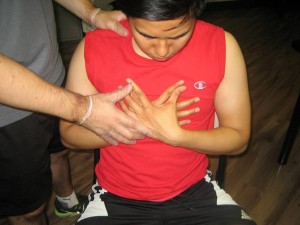Slipping rib syndrome happen once the cartilage on the lower ribs drives and moves, and cause discomfort in the chest or upper abdomen. Women are more susceptible to this condition than with men.
Symptoms of slipping rib syndrome
- Slipping, popping or clicking sensations felt in the lower ribs
- Difficulty breathing
- Intermittent sharp stabbing pain felt in the upper abdomen or back and eventually becomes dull along with achy sensations
- Symptoms become severe especially when coughing, bending, lifting, sneezing, stretching, deep breathing and turning in bed.
Intermittent sharp stabbing pain felt in the upper abdomen or back and eventually becomes dull along with achy sensations - In most cases, the condition happens on one side or unilateral, but it can also happen in both sides of the rib cage or bilateral.
Causes
- Hypermobility of the rib cartilage or ligaments. These ribs are not attached to the sternum, but connected to each other by loose fibrous tissue. They are sometimes called false ribs and susceptible to injury, trauma or hypermobility.
- Irritation of the nerve due to slippage or movements and can strain some muscles in the area and result to pain and inflammation.
- Continuous severe coughing
- Asthma
- Cold allergy
- Fragility of the stern costal, costochondral and costovertebra which are the ligaments that holds the ribs in their proper positions.
- Injuries to the chest wall
- Sinusitis
Treatment
- Take plenty of rest especially the affected area. Generally, avoid performing strenuous activities that result to pain in the chest.
- Apply cold compress on the affected area to lessen the pain and the swelling. Cold compress can be in the form of an ice pack or face cloth soaked in cold water and placed on the area.
- Apply heat on the area in the form of a warm compress to lessen the spasms of muscles and stiffness of the joint. Another alternative is taking a warm bath.
- Take the prescribed pain medications such as acetaminophen or nonsteroidal anti-inflammatory medication such as ibuprofen and naproxen to lessen the pain and inflammation.
- Prolotherapy strengthens the weak muscles or ligaments that cause the slipped rib. It stimulates repair of painful or damaged areas by inducing a mild inflammatory in the weak ligaments. It stimulates the fast healing of the condition.
- Perform mild exercises to strengthen weak ligaments or muscles in the chest area with the help of the physical therapist. In addition, perform segmental breathing to restore mobility in the ribs.
- Use the prescribed corticosteroid injections to lessen the swelling.
Disclaimer / More Information
The material posted on this page on slipping rib syndrome is for learning purposes only. Learn to recognize and manage the condition by taking a first aid and CPR class with one of our training providers.
FACT CHECK
https://www.healthline.com/health/slipping-rib-syndrome

